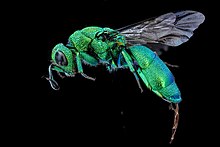| Cuckoo wasps Temporal range:
| |
|---|---|

| |
| Scientific classification | |
| Domain: | Eukaryota |
| Kingdom: | Animalia |
| Phylum: | Arthropoda |
| Class: | Insecta |
| Order: | Hymenoptera |
| Superfamily: | Chrysidoidea |
| Family: | Chrysididae Latreille, 1802 |
| Subfamilies | |
Commonly known as cuckoo wasps or emerald wasps, the hymenopteran family Chrysididae is a very large cosmopolitan group (over 3000 described species) of parasitoid or kleptoparasitic wasps, often highly sculptured,[1] with brilliant metallic colors created by structural coloration.[2] They are most diverse in desert regions of the world, as they are typically associated with solitary bee and wasp species, which are also most diverse in such areas. Their brood parasitic lifestyle has led to the evolution of fascinating adaptations, including chemical mimicry of host odors by some species.[3]
- ^ Cite error: The named reference
Chrysis-generalwas invoked but never defined (see the help page). - ^ Agnoli, Gian Luca; Rosa, Paolo (20 September 2013). "Chrysidid coloration". Chrysis.net. Archived from the original on 28 December 2017. Retrieved 16 June 2015.
- ^ Pauli, Thomas; Castillo‐Cajas, Ruth (25 August 2018). "Phylogenetic analysis of cuckoo wasps (Hymenoptera: Chrysididae) reveals a partially artificial classification at the genus level and a species‐rich clade of bee parasitoids". Systematic Entomology. 44 (2): 322–335. doi:10.1111/syen.12323.